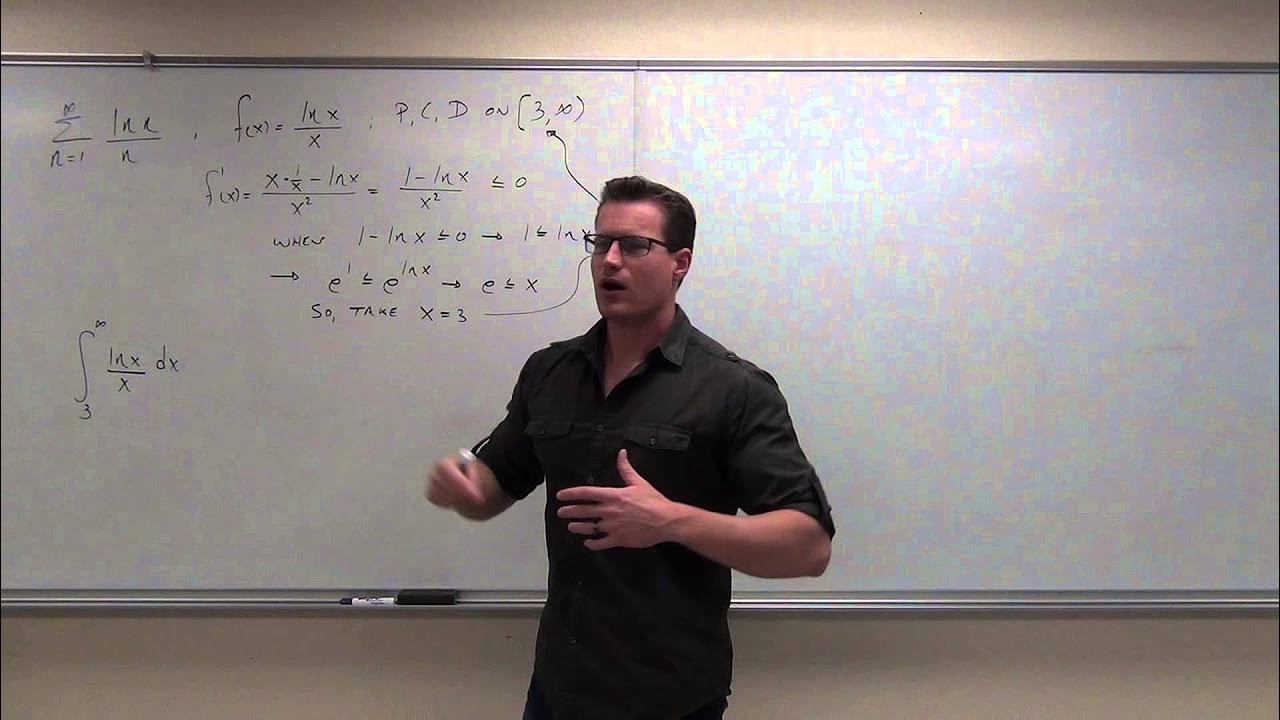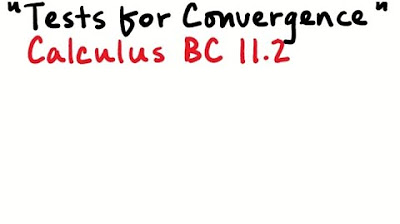Calculus 2 - Integral Test For Convergence and Divergence of Series
TLDRThe video script discusses the application of the integral test to determine the convergence or divergence of various series. It explains the conditions required for the integral test to be applicable and provides detailed examples, including the harmonic series and a series involving a function with a complex denominator. The examples demonstrate how to set up and evaluate the integral, leading to conclusions about the series' behavior. The script is informative and mathematically rigorous, offering a clear understanding of the integral test and its utility in series analysis.
Takeaways
- 📊 The integral test is used to determine the convergence or divergence of a series by examining the corresponding function's integral from 1 to infinity.
- 📈 The function for the integral test must be positive, continuous, and decreasing on the interval from 1 to infinity.
- 🌟 If the integral converges to a finite value, the series also converges; if the integral diverges to infinity, the series diverges as well.
- 🔄 The first example in the script involves a series of the form 1/n + 2^2. The corresponding function f(x) = 1/x + 2^2 is analyzed for the integral test.
- 🛑 The function in the first example has a vertical asymptote at x = -2, but it is continuous from 1 to infinity, thus satisfying the conditions for the integral test.
- 📶 The first derivative of the function in the first example is found to be negative from 1 to infinity, indicating that the function is decreasing on this interval.
- 🔢 The improper integral of the function in the first example converges to a finite value, 1/3, indicating that the series converges according to the integral test.
- 🔍 The second example examines the series 2n / (3n^2 + 4). The corresponding function f(x) = 2x / (3x^2 + 4) is continuous and positive for x >= 1.
- 📉 The function in the second example is found to be decreasing from 2 to infinity, not from 1 to infinity, so the integral test is applied only to the interval from 2 to infinity.
- 🌐 The integral of the function in the second example diverges to infinity as x approaches infinity, indicating that the series from 2 to infinity diverges, and by extension, the series from 1 to infinity also diverges.
- 📚 The harmonic series, a classic example, is shown to diverge using the integral test, as the integral of 1/x dx from 1 to infinity diverges to infinity.
Q & A
What is the series in question at the beginning of the transcript?
-The series in question is the sum from 1 to infinity of 1/n, plus the sum from 1 to infinity of 2^n.
What is the Integral Test and how is it used to determine the convergence or divergence of a series?
-The Integral Test is a method used to determine whether a series converges or diverges. It states that if the integral from 1 to infinity of a function f(x) converges to a finite value, then the series also converges. Conversely, if the integral diverges to infinity or does not converge, then the series also diverges. The function used in the integral must be positive, continuous, and decreasing on the interval from 1 to infinity.
What are the conditions that a function must satisfy for the Integral Test to be applicable?
-For the Integral Test to be applicable, the function must be positive, continuous, and decreasing on the interval from 1 to infinity.
How is the continuity of the function f(x) = 1/(x+2)^2 established in the script?
-The function f(x) = 1/(x+2)^2 is continuous from 1 to infinity because it does not have any points of discontinuity in this interval. The only point of discontinuity is at x = -2, which is outside the interval being considered.
What is the first derivative of the function f(x) = 1/(x+2)^2, and what does its sign indicate about the function?
-The first derivative of the function f(x) = 1/(x+2)^2 is -2/(x+2)^3. The sign of the first derivative indicates that the function is decreasing on the interval from 1 to infinity because the derivative is negative for all x greater than -2.
What is the value of the improper integral that is used to test the convergence of the series in the first example?
-The value of the improper integral for the first example is 1/3. This indicates that the integral converges, and by the Integral Test, the series also converges.
How does the script modify the second series to make the Integral Test applicable?
-The script modifies the second series by considering it from 2 to infinity instead of from 1 to infinity, because the function is decreasing and continuous on this interval, making the Integral Test applicable.
What happens to the integral from 2 to infinity of the function f(x) = 2x / (3x^2 + 4) in the script?
-The integral from 2 to infinity of the function f(x) = 2x / (3x^2 + 4) diverges to infinity, indicating that the series also diverges.
How does the script demonstrate that the harmonic series diverges using the Integral Test?
-The script demonstrates that the harmonic series diverges by showing that the integral from 1 to infinity of 1/x dx diverges to infinity, as the natural log of infinity is infinity.
What is the final series considered in the script, and what is its outcome with the Integral Test?
-The final series considered is 2/(n^2 + 6n + 10). The Integral Test shows that the series converges because the integral from 1 to infinity of the corresponding function converges to a finite value, specifically pi/2 - 2*arc tan(4).
Outlines
📚 Introduction to the Integral Test
This paragraph introduces the integral test for determining the convergence or divergence of a series. It explains that the integral test is applicable when the sequence can be described as a positive, continuous, and decreasing function on the interval from 1 to infinity. The integral test states that if the integral of the function from 1 to infinity converges to a finite value, then the series also converges; if the integral diverges, the series does too. The paragraph sets up the problem of testing the series 1/n + 2^2 for convergence or divergence using the integral test.
🧠 Applying the Integral Test to a Specific Function
The paragraph delves into the application of the integral test to the function 1/(x + 2)^2. It discusses the conditions for the integral test to be applicable, which include the function being positive, continuous, and decreasing on the given interval. The function is found to be continuous from 1 to infinity, despite having a vertical asymptote at x = -2, and its first derivative is calculated to show that it is decreasing on this interval. The integral of the function from 1 to infinity is evaluated using u-substitution, leading to a finite value, which by the integral test, indicates that the series converges.
📈 Evaluating an Improper Integral and Series Convergence
This paragraph continues the discussion on series convergence by evaluating an improper integral and applying the integral test to a new series. The function 2x / (3x^2 + 4) is examined for positivity, continuity, and decreasing nature. The first derivative of the function is calculated using the quotient rule, and it is determined that the function is decreasing from 2 to infinity, not from 1 to infinity. The integral from 2 to infinity is found to diverge to infinity, indicating that the series also diverges. The paragraph concludes by explaining that since the series from 2 to infinity diverges, the original series from 1 to infinity must also diverge.
🌐 Understanding the Divergence of the Harmonic Series
The harmonic series, defined as the sum of the reciprocals of the natural numbers, is discussed in this paragraph. It is known to diverge, and the integral test is used to demonstrate this divergence. The function 1/x is shown to be positive, continuous, and decreasing from 1 to infinity. The integral of 1/x from 1 to infinity is calculated, and as the anti-derivative of 1/x is the natural log of x, the limit of this integral as it approaches infinity results in infinity minus zero, confirming the divergence of the integral and hence the series.
🔄 Completing the Square and Trig Substitution
The paragraph focuses on using trigonometric substitution to evaluate the integral of a function involving a quadratic expression in the denominator. The series 2/(n^2 + 6n + 10) is rearranged to complete the square, resulting in a new function 2/((x + 3)^2 + 1). The function is analyzed for positivity, continuity, and whether it is a decreasing function. Trig substitution is applied by setting x + 3 = tan(θ), and the integral is transformed into a form involving the arctangent function. The integral from 1 to infinity is evaluated, and the limit as it approaches infinity converges to a finite value, indicating that the series converges.
Mindmap
Keywords
💡Series Convergence
💡Integral Test
💡Positive Function
💡Continuous Function
💡Decreasing Function
💡First Derivative
💡Improper Integral
💡U-Substitution
💡Trig Substitution
💡Harmonic Series
💡Power Rule
Highlights
The integral test is used to determine the convergence or divergence of a series.
For the integral test to apply, the function must be positive, continuous, and decreasing on the interval from 1 to infinity.
The function f(x) = 1/(x + 2)^2 is positive and continuous on the interval from 1 to infinity, except at x = -2 where there's a vertical asymptote.
The first derivative of f(x) = 1/(x + 2)^2 is negative on the interval from 1 to infinity, indicating that the function is decreasing.
The integral of f(x) = 1/(x + 2)^2 from 1 to infinity converges to a finite value, hence the series also converges according to the integral test.
The series 2n / (3n^2 + 4) is examined using the integral test to determine its convergence or divergence.
The function 2x / (3x^2 + 4) is continuous and positive on the interval from 1 to infinity.
The first derivative of the function 2x / (3x^2 + 4) is found using the quotient rule.
The function 2x / (3x^2 + 4) is not decreasing on the interval from 1 to infinity, thus the integral test cannot be applied on the entire interval.
The integral from 2 to infinity of the function 2x / (3x^2 + 4) diverges to infinity, implying the series also diverges.
The harmonic series is shown to diverge using the integral test, with the integral of 1/x from 1 to infinity diverging to infinity.
For the series 2/(n^2 + 6n + 10), the integral test is applied after rearranging the expression and completing the square.
The function f(x) = 2/(x + 3^2 + 1) is positive, continuous, and decreasing on the interval from 1 to infinity.
The integral of f(x) = 2/(x + 3^2 + 1) from 1 to infinity is evaluated using trigonometric substitution.
The integral converges to a finite value, indicating that the series 2/(n^2 + 6n + 10) also converges.
The integral test is a powerful tool for determining the convergence of series when the general term can be modeled by a function that satisfies certain conditions.
The application of the integral test involves understanding the behavior of functions, their derivatives, and the computation of improper integrals.
Transcripts
Browse More Related Video

Calculus 2 Lecture 9.3: Using the Integral Test for Convergence/Divergence of Series, P-Series

Infinite Series Multiple Choice Practice for Calc BC (Part 6)

Integral Test and p-Series

Calculus 2 - Geometric Series, P-Series, Ratio Test, Root Test, Alternating Series, Integral Test

Infinite Series Multiple Choice Practice for Calc BC (Part 3)

Tests for Convergence
5.0 / 5 (0 votes)
Thanks for rating: